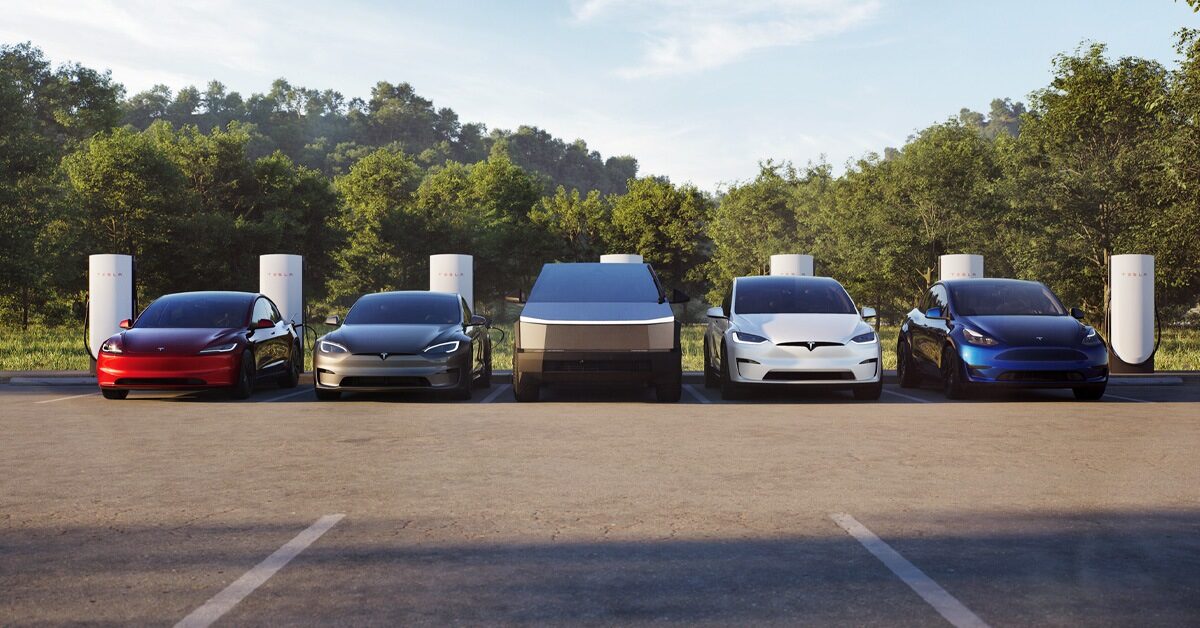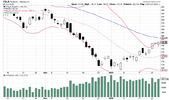ThisStockGood
Still cruising my Model S 70 2015
I smell a 10 % day.TSLA trading at 139.80 Euro = $152.62 which more than at after hours.
Not sure about the direction. But still.
You can install our site as a web app on your iOS device by utilizing the Add to Home Screen feature in Safari. Please see this thread for more details on this.
Note: This feature may not be available in some browsers.
I smell a 10 % day.TSLA trading at 139.80 Euro = $152.62 which more than at after hours.
Elon mentioned wind and solar as one of the 3 tiers of a sustainable future.
Would wind turbines make sense?
I'm pretty sure he's referring to the Gen 3 vehicle, the affordable compact they will speak more about at Investors Day in two months.

Yes, I've been saying for years that the 50% CAGR that Tesla guides for is to be evaluated from a 2020 base.50% CAGR from baseline 2020 deliveries (the 'blue' bars) would be 1.6875 million deliveries in 2023. We may stay above the trendline, which Tesla did NOT plot on this graph.
In this graph, Tesla's essential message is that, even though analysts called Q4 deliveries a 'miss', the trend for cumulative deliveries (ie: the 'big picture') is STILL solidly above guidance, which has remained steadfast since 2020.
The world has wobbled badly twice since 2020, while Tesla motors on!
Cheers to the Longs!
Dojo and inference . . . Elon is speaking over the heads of all of these analysts.
They won't get ituntileven when FSD goes out of beta.
You’re missing something important in “what changed.” Besides Tesla production and macro environment, another factor is competitor production, particularly BYD. It is no longer true that Tesla has no competitors. So supply and demand is impacted by the production of all competitors, not just Tesla.All this talk about “demand problems” have me experiencing flashbacks to Econ 101. It’s really simple.
Did Tesla have demand problems at their old prices? Not at the start of 2022, at the production rate of early 2022. That’s why prices rose, so their order books wouldn’t grow further.
Did Tesla have demand problems at their old prices at the end of 2022, at the production rates at the end of 2022? Absolutely.
What changed? Macro environment and production rate.
Seriously, this is trival economics. Tesla lowered their prices because they had a demand problem in December. They’re tweaking them back up because demand is exceeding current production rates, but their prices are based off of future (higher) production rates.
Tesla will ask as much as they can get for their vehicles to balance order rates with production rates. Supply vs demand. If they lower prices, it’s because there’s not enough D for the S. If they raise them, there’s not enough S for the D.
We are currently entering a deflationary period with fears of recession, and the cost of borrowing money is high. Tesla’s also significantly ramping production. This brings prices down.
If we get past the recession fears and interest rates start coming back down, we’ll probably see prices go back up.
There’s no conspiracy here, and it’s not a Tesla problem. It’s simple economics and Tesla’s just reacting to the macro environment. All other companies will have to do the same.
Fortunately for us, Tesla knows how to minimize cost, giving them wide berth to make such decisions. Others don’t have that luxury. Watch as some competitors suffer under the pricing pressure this year.
I haven’t heard the call yet. Will do so tonight when my boy gets to bed. Any mention of the Roadster? I’m guessing no but we are curious. Thanks!
In less than a month we're up 50% from the intra-day low in early January.
Spare a thought for the Tesla Economist. What price did he sell out at I wonder

Which makes me wonder if they dropped the price too much. You want to keep your price just enough for the demand to exceed production by about 10% and not more..
We’re focusing on operating margins and not vehicle margins this year.
This plus them walking around the general topic of GM suggests to me margins on autos are going to be quite a bit lower.
Say this slowly three times: There is no "EV" market There is a huge market for cars/trucks.When a company prices its products to drive all other competitors out of business, you need to factor in growth and consequently a higher P/E. Even if overall profit stays the same, share price can double once it becomes clear that the US EV market is increasingly becoming a one-player market.
On Tip Ranks, this analyst is rated 0.5 / 5 stars and ranked at # 7,671 out of 8,294 WS Analysts, with a success rate about the same as flipping a coin.
Gordon Johnson | GLJ Research Stock Analyst - TipRanks.com
Gordon Johnson is a 0.29-star Wall Street Analyst at GLJ Research. Gordon Johnson's focuses on the Basic Materials sector and covers 36 stocks with a 55.87% success rate.www.tipranks.com
Almost everyone active in putting together utility-scale projects is already doing this and has the necessary relationships & knowledge. (And in fact the international standards increasingly require this stuff). Sometimes utility-scale stuff is led by the utility itself using in-house project teams; sometimes there are commercial developers who then (often) flip all or part of the completed project; and in some instances a project development team might be led by the turbine manufacturer. (Often these projects are consortia, and the members bring knowledge & skills to the table as well as capital). So even where (say) RES might be the developer (for a consortium) they would still solicit 'autobidder' bids from the other vendors to evaluate on a level playing field basis against their own in-house 'autobidder', so as to be able to justify the autobidder product selection in exactly the same way as they would need to justify the turbine make/model/etc selection, etc. And the project development lead might not be the operations lead partner and that might also have an influence on these matters. But bottom line, whilst Tesla is a big player in utility scale storage it is by no means the only player.I doubt it. But a partnership with a wind turbine company for auto bidder and megapack combined to go with a wind turbine would be very interesting.
In my opinion (i.e. experience) this is actually very well explored territory, but not very fruitful at small scale. Fantastically interesting, but the real usefulness is acting as pilots and model validation for much larger stuff.Most promising on a domestic light industrial scale is some form of solar/wind/heat capture.
There are some good PVT solutions, and some small scale hybrid solar/wind products, but it is largely unexplored territory..
Tesla currently has no end of good product ideas, and it is very likely these areas are not even on the list.
I mentioned them only because what can be done with EVs, Solar, Wind and Batteries far exceeds what we have currently done.
I was trying to gently point out why Tesla wouldn't go in that direction of small scale wind. Maybe I should have have been clearer, less gentle.That you even consider it a possibility that Tesla would enter the small-scale wind market makes me realize how little you understand how Tesla makes business decisions.
There is zero chance Tesla would ever enter the market that is small scale wind and the chances of them going into large wind turbines is almost as small. The former should be clear based on nothing more than the unfavorable physics/economics of small-scale wind and the latter because Tesla has never publicly entertained the idea of manufacturing wind turbines and there is no new information to lead us in that direction.
It's also unclear to me why you are suggesting that Elon's stance of including wind alongside solar has changed as of late. As long as I can remember, Elon has always included wind alongside solar and nuclear when it comes to displacing fossil fuel generation. Nothing has changed, and it's unclear why you are suggesting it has.


